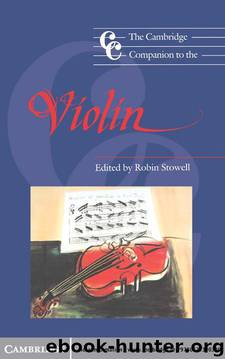The Cambridge Companion to the Violin (Cambridge Companions to Music) by Robin Stowell

Author:Robin Stowell [Stowell, Robin]
Language: eng
Format: epub
Publisher: Cambridge University Press
Published: 1992-12-10T02:00:00+00:00
The Classical period
The Classical period was one of remarkable transition in the genre from the violin sonata with keyboard continuo to one with keyboard obbligato. But the idea of equality between violin and keyboard, suggested by J. S. Bach’s sonatas, was not taken up by his immediate successors. Some composers sat very much on the fence, using the keyboard alternately as an accompanying continuo instrument and as a combination of melody instrument and supporting bass,41 while others contributed to the decline of the violin’s importance (and hence to the dominance of the keyboard) by cultivating the so-called ‘accompanied’ sonata.42 Nevertheless, the demand for sonata composition, considerable in the first half of the eighteenth century, seems to have increased even more when the keyboard part was written out; and although flexibility of instrumentation persisted at the start of the period, composers later began to assign their works in the genre to a specific melody and keyboard instrument, the preferred keyboard instrument increasingly becoming the piano.
Italy
Numerous distinguished Italian composers of sonatas followed in the footsteps of Tartini, among them Campioni,43 Ferrari, Lolli, and Tartini’s most renowned pupil, Nardini. Their works display a growing awareness of the harmonic structure and ordered design of the evolving Classical style, Nardini’s second-movement Allegros approximating the scheme of Classical sonata form. Furthermore, those of Ferrari and Lolli (especially Lolli’s Op. 9 set) were technically demanding, requiring mastery of, for example, harmonics, scordatura, sul G playing, daring leaps and cadenza-like interpolations.
Another vital link in the continuous tradition from Corelli to Viotti was the latter’s principal mentor, Gaetano Pugnani, whose sonatas (Opp. 3, 7 and 8, c.1760–74) adopt a fast-slow-fast design with the opening Allegro movements close to Classical sonata form. Viotti’s sonatas are largely retrospective ‘continuo’ sonatas, showing an understandable preference for the violin. But Pugnani’s progressive tendencies were explored further by Sammartini and especially Boccherini, who contributed a dozen or so accompanied keyboard sonatas in fast–slow–fast format with fully elaborated keyboard parts.
It is sometimes difficult to distinguish between the styles of Mozart and the Bohemian Mysliveček, who spent much of his life in Italy. Certainly, Mysliveček’s six accompanied sonatas (London, 1775) display a striking resemblance to Mozart’s early style; in the words of Schoenbaum: ‘In Mysliveček’s compositional art, Czech musicality merges with Italian influences to form an individual style, whose formal balance and harmonic variety paved the way for the Viennese Classical masters.’44
France
The numerous pupils of Gaviniès made their mark in Paris around the third quarter of the century, writing idiomatically for the instrument in a harmonically inventive, highly expressive style which has been called a ‘French Storm and Stress’. Notable among them for their sonata compositions are Leduc, Guénin and Capron. Although Guénin bowed to the trend towards the keyboard sonata with ad libitum violin accompaniment, he did not make the violin totally subservient to the keyboard, occasionally using the term ‘solo’ to indicate sections of prominent violin writing. Saint-Georges, too, seems to have taken pains to treat violin and keyboard as equal protagonists in his three extant sonatas.
Download
This site does not store any files on its server. We only index and link to content provided by other sites. Please contact the content providers to delete copyright contents if any and email us, we'll remove relevant links or contents immediately.
The Goal (Off-Campus #4) by Elle Kennedy(13207)
Kathy Andrews Collection by Kathy Andrews(11340)
Diary of a Player by Brad Paisley(7270)
What Does This Button Do? by Bruce Dickinson(5936)
Assassin’s Fate by Robin Hobb(5863)
Big Little Lies by Liane Moriarty(5521)
Altered Sensations by David Pantalony(4872)
Pale Blue Dot by Carl Sagan(4628)
Sticky Fingers by Joe Hagan(3916)
The Death of the Heart by Elizabeth Bowen(3342)
The Heroin Diaries by Nikki Sixx(3326)
Beneath These Shadows by Meghan March(3154)
Confessions of a Video Vixen by Karrine Steffans(3104)
The Help by Kathryn Stockett(3023)
How Music Works by David Byrne(2968)
Jam by Jam (epub)(2881)
Harry Potter 4 - Harry Potter and The Goblet of Fire by J.K.Rowling(2814)
Strange Fascination: David Bowie: The Definitive Story by David Buckley(2702)
Petty: The Biography by Warren Zanes(2575)
